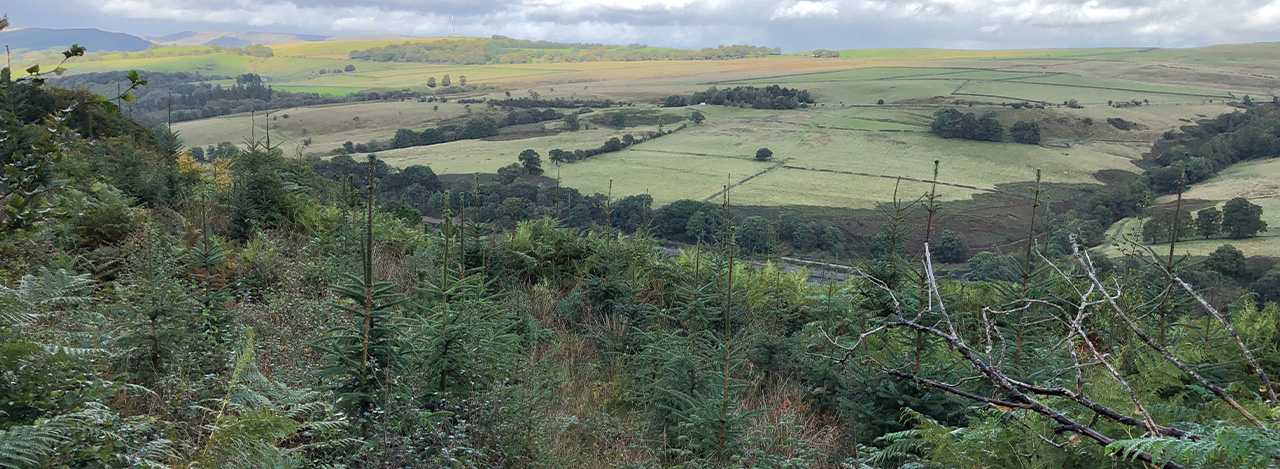
Above: Recently planted larch growing to the west of Fernilee Reservoir is already starting to obscure the views across the valley and crowd out the native broadleaf trees.
Forestry England’s plans for the valley
Dan Pincott works for Forestry England (previously called The Forestry Commission) and is a member of the Goyt Valley Facebook Group. This is his response to my criticism of the FE’s plans to replant the recently cleared areas of dense larch (view post).
I am glad we have the opportunity to discuss this as I think it is important that correct information is available to stakeholders and people interested in this beautiful area.
To answer your comment that we have restocked above Fernilee, we have carried out no restock operations in the recent statutory plant health notice (SPHN) area, this will require ground preparation before this happens. You may be looking at an old restock site (SK 0106 7659) below the fire track which was restocked in 2016. Or you may be noticing natural regen.
In regards to long term plans etc, it is business as usual following on from a harvesting operation. This area will under go ground preparation and re stock. We will be planting a diverse as possible range of species to future proof it against tree disease and climate change whilst being able to supply good quality timber for future generations. This will include and element of broadleaf and clough regeneration.
Forestry England are responsible for the sustainable management of the nation’s forests, taking into account the need for timber production, safeguarding wildlife and supporting recreation. This is a delicate balancing act, upon which we are regularly audited under the Government’s UK Forestry Standard (UKFS) and the independent UK Woodland Assurance Standard (UKWAS).
Timber harvesting and other forestry work need to takes place all year round to ensure continuity of supply of timber to UK mills and sustainable management of our woodlands. The work in the woodlands is in response to a phytophthora ramorum outbreak, an algae-like organism that kills larch and potentially other trees and which is also associated with rhododendron. We are required by law to remove the infection within a short period of time. Prior to work taking place our team surveyed the sites to ensure that work will not adversely impact wildlife, including nesting birds, and that we are working within any environmental constraints.
Timber felling and harvesting work often looks dramatic but sites soon recover and we will replant any felled areas. The timber will be used in UK sawmills and helps to support the economy and reduce imports of timber on which the UK is reliant.
More information on the ongoing Goyt work can be found at: https://www.forestryengland.uk/article/tree-felling-goyt-valley-stop-disease there is also a good video done by the central England FD team to explain a bit more about what is needed and why.
You mention a hope to see less Larch in the valley. This will be the case as this is primarily to species we have to remove as it is a host for PR. We will not be planting Larch at the Goyt valley for some time. It is a shame for this species as it has fantastic timber qualities we use for building, fencing and many other everyday products we take for granted.
To address your comment from the website and email of us clearing the brush wood and branches. For the health of a woodland it is essential this is not removed. It is a valuable nutrient resource for it to return to the soil. We often require a form of ground operation, usually on flatter ground where this is mulched before scarification and restock, but on steeper sites such as the Goyt, we will look at mounding and leaving the brash in situ to rot down. There are a number of articles you can find from Forest Research online on the importance of brash and its role in woodland and soil health.
In addition, I would also like to state that we are a small team at West Beat covering a very large area, often dealing with sensitive and complex sites. We currently have only three full time members of staff and cover the Goyt Valley, Upper Derwent sites at the Snake, Lockerbrook, Ouzleden and West End. Matlock Moor, Cromford/Black Rocks and Shining Cliff and South Yorkshire sites of Wombwell, Wharncliffe and Old Park.
As you can imagine, dealing with the level of tree disease across many of these sites is a very full on job and whilst it would be nice to explain to each person in detail why we carry out our essential work it is not always possible to do so and that is why we have asked for help in this in regards to the website, video and signage onsite.
We receive a high level of enquiries and I try to respond to these within 10 working days where I can, but this must be balanced with my day to day work.
I think it is good to see you have an interest in the Goyt valley, as well do I. Having lived locally for a number of years and I think we both want the best for the area. Please consider how powerful social media can be for good and bad. It is important local people who care about this area are given correct information.
Dan Pincott
Beat Forester, Forestry England